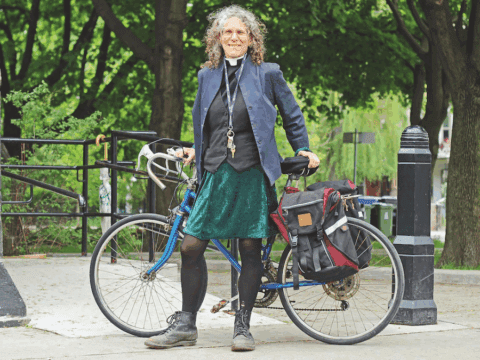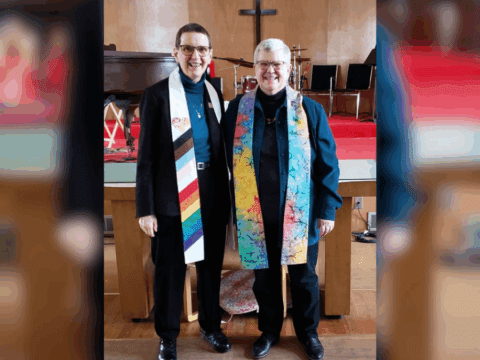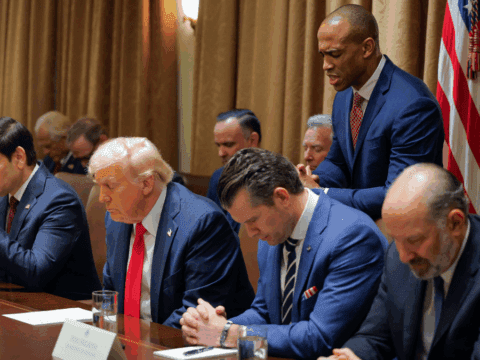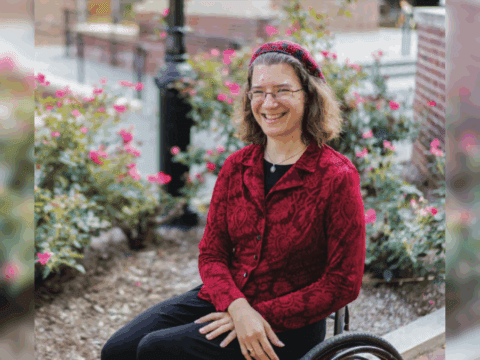The first thing they tell me when we meet, just before 2 p.m. on a crisp Saturday in March, is to watch out for the mean man named Henry on the third floor. “Hold on to the railing when you’re on the stairs. We think he might push someone.” As well as being mean, there’s something unusual about Henry: he’s dead.
I’m standing in the gravel parking lot of the Players’ Guild theatre in Hamilton, conferring around parked cars with a trio of paranormal investigators from a team called The Searcher Group. Peter Roe — wearing a fleece sweater from the historic witch-hunting city of Salem, Mass. — James McCulloch and the moustachioed Palmisano brothers, Richard and Paul, are here to collect evidence and learn the histories of the ghosts on the property. They tell me there are at least four, based on their visit the previous autumn.
Staff at the community theatre, North America’s oldest, reached out to Roe last year because they sometimes felt like they weren’t alone — especially on the third floor and in the basement where they often work late at night, finding costumes or organizing props. One member heard a whisper in her ear as she went to lock the front door one night: “Help me! Get me out of here!” She turned around, expecting to see a friend playing a trick on her. There was no one there.
Once strange stories started swirling around the theatre, the haunting became part of the space’s mythology. The front page of its website boasts of “rumours of a ghost in the costume room,” adding it to the list of thousands of houses, churches and other landmarks rumoured to be haunted worldwide. In his 2013 book, Paranormal Nation, Marc E. Fitch argues that the growth of the Internet and the after-effects of 9-11 have pushed people toward the paranormal; extraordinary explanations for unusual experiences can bring order to the chaos of an isolating, uncertain world. The pop culture world has certainly picked up on this yen for the paranormal. Ghost Hunters, a reality TV show where investigators run around haunted houses with expensive recording gear and night-vision goggles, is in its 11th season; single-episode viewership has reached as high as 3.1 million. Innumerable movies with occult and paranormal themes come to the big screen every year, and Stephen King dominates bestseller lists.
For many, ghosts are more than just spooky fiction. A 2007 Ipsos Reid poll found that 48 percent of Canadians believe that ghosts are real; American and British surveys have come up with similar results. Ten percent of Canadians think that they’re living with a spirit in their house, and 18 percent say that they have been in the presence of a ghost at least once. It cuts across cultures. “Like in the West, people in Asia have kept their belief in ghosts despite the rise of science, skepticism, secularism and public education,” Justin McDaniel, professor of religious studies at the University of Pennsylvania, told The Atlantic in 2014. “In places like Japan where secularism is very strong, the belief in ghosts is still high. Even hyper-modern and liberal Scandinavia has a higher percentage of people believing in ghosts.”
The idea that the dead can live on as earthly spirits has been around almost as long as death itself. Ghosts link our modern world to antiquity: for all of our education and technological sophistication, we are as fascinated and terrified as our ancestors were by things that go bump in the night. But it’s not something that many of us readily talk about. When I told people about working on this story, at least half shared their own ghost story with me, rushing through it with apparent relief. Many of them peppered their stories with qualifiers: “I don’t believe in ghosts, but…” or, “It was probably nothing.” I don’t think anyone’s ever spontaneously told me a story without first receiving reassurance that I’d be willing to take the experience seriously. There’s a fear of being dismissed, of being laughed at.
That’s why people turn to Richard Palmisano, who’s serious about using modern instrumentation to detect and record evidence of the paranormal. I’m among the 52 percent of Canadians who do not believe in ghosts. But I’m fascinated by the 48 percent who say they do, and that’s why I find myself sharing coffee with Palmisano two months before we convene at the Players’ Guild theatre in Hamilton. He explains how he came to found The Searcher Group 37 years ago.
As a child, Palmisano heard strange things in his own west Toronto home — whispers, footsteps, scraping — and all with no human explanation. “I didn’t even understand what paranormal was, I just knew something weird was going on,” he says. “At that age, I was afraid of it.” Curiosity eventually overtook fear: in 1979, at age 18, he decided to start the group. Richard recruited his brother Paul who had experienced many of the same strange noises in their childhood home.

Now, they respond at no charge to requests from businesses and homeowners, arriving on site laden with silver briefcases full of equipment, ready to pick up evidence of ghostly presences. They research the history of the building, matching names they detect to people who have been in the same space in the past. They share the information with their clients, introducing them to the non-living in their midst. “We’re always looking for the answers of what goes on after death,” Richard Palmisano says. “Does the soul exist beyond physical death? That’s what I’m looking for: physical proof.”
He’s filled out the team with a rotating cast of volunteers, including Roe, whose introduction to the paranormal was more intentional. Roe never had any paranormal experiences while growing up, but was fascinated by the possibility. So he started his own investigations of Fort George in Niagara-on-the-Lake, Ont., leaving a recorder behind in a deserted tunnel in the two-century-old fortification while he waited outside. When he listened back, there were taps, steps and creaks close to the device that he couldn’t explain, but he was most startled by the repeated loud sound of something heavy being dragged across the stone. He contacted Richard Palmisano after reading one of his books, and is still investigating with the group over five years later.
At the Players’ Guild, Roe rings the buzzer at the theatre’s back door, and we’re ushered into the kitchen. The Palmisano brothers take a large Tupperware bin to the front parlour to set up one of two cameras that will run all night, while Roe and McCulloch set up a base camp in the performance space and start unloading equipment from their silver cases. McCulloch’s has “Ghost Gear” written in black ink on the foam holding everything in place. They grab the basics: hand-held voice recorders and gauss readers, which beep and tick in response to electromagnetic fields.
A number of theatre people are hanging around, but soon everyone leaves except for Carolyn Marshall, the woman who first let us in to the space, and her two adult children, Charlotte and Nathan. They’ve all spent years in the building, and the first step in the investigation is to walk through the house and have them tell us about what they’ve experienced and where, a process that takes about an hour. We switch our recorders on.
The current Queen Street home of the Players’ Guild was built as a private residence in 1878, after the previous owner of the land it sits on was stabbed to death. The building has housed a judge, Hamilton’s pre-eminent coffin maker, and by the early 1950s, a theatre troupe with roots dating back to 1875. The theatre removed a wraparound porch and added an extension to the south side of the building, but it mostly stands as it did in the late 19th century. It’s a house with a complicated past, and that often goes hand in hand with rumours of ghostly encounters.
The Holy Ghost of Christianity is very different from the kind Palmisano and his team are seeking. Understood as one of three manifestations of God, it is not a dead person lingering behind. Accordingly, Christians have historically taken a dim view of earthbound spirits.
In the 17th century, Protestant leaders condemned belief in ghosts, insisting that departed souls go directly to either heaven or hell. That view has pretty much prevailed to this day. Anglican theologian John Stafford Wright wrote a pair of books in 1977 and 1984 about the supernatural, which were republished posthumously as one volume in 2011. “There is nothing in Scripture to suggest that the departed are all around us and watching what we are doing,” he wrote, admitting, however, that he couldn’t find anything in scripture that forbids the belief. Roman Catholic theology is more open to the idea of ghosts, because Catholics believe in purgatory, an in-between state where some souls are purged from their sins before ascending to heaven. These souls are more likely to reappear on Earth to warn people against their sinful ways.
Modern Catholic and Protestant theologians interpreting scripture might say that the occasional appearance of a disembodied spirit is theoretically possible, but could only occur with God’s approval. They would take their cue from the Old Testament, where King Saul enlists a medium to help him speak with the deceased prophet Samuel. The prophet appears, but Saul dies soon after. The lesson, according to Stafford Wright: “the Bible bans deliberate contact with the spirit world other than with God.”
But that doesn’t stop many Christians from having their own thoughts about ghosts. According to a 2009 poll conducted by the Pew Forum on Religion and Public Life, 20 percent of white evangelical Christians believe they’ve seen or communicated with someone dead. That number gets even higher in other demographics: 29 percent for white mainline Protestants, 35 percent for white Catholics and 37 percent for black Protestants. A recent poll in the United Kingdom found that Britons are actually more likely to believe in ghosts than God.

Michele Stableford, a professional medium and friend of The Searcher Group, would certainly consider herself someone who believes in ghosts. It’s mid-afternoon during my day with the investigators when Roe brings her to the Players’ Guild theatre. He met her a few blocks away; until now, the address was kept from her so she couldn’t research the house in advance. She leads us to the basement to start searching for spirits.
It’s dark, the only light coming from a door we’re passing through and some small frosted windows on the far wall. I walk through the door. It scrapes shut a couple of inches, pushing the brick that’s keeping it open. “Okay, I didn’t touch that door!” Nathan Marshall says behind me. I stop walking, content not to venture farther than I already have. Stableford walks forward another six or so feet, looking around. “He doesn’t want us in here,” she says. “He’s very negative. It’s like he’s still angry that he died.”
“Tag, my stomach,” says Roe. He does this frequently, telling his voice recorder about sounds that he and others in the group make, even if they’re not speech, lest anyone mistake them for ghost noises. We continue through the house for the next two hours, going from room to room as Stableford tells us about people that the rest of us can’t see. It’s about 5 p.m. by the time we decide to break for dinner.
Even though we’re heading out of the house for food, this is perhaps the most important part of the investigation. The video cameras and voice recorders are left running while we’re gone. “Spirits are social,” Richard Palmisano says. “They’ll talk just like you and I talk, and we’ll gain lots of information like names and things that are going on.” The hope is that they’ll talk to each other more freely when there aren’t any living intruders among them.
I volunteer to leave my recorder behind, too, placing it in a room on the second floor. Roe suggests putting it on something plastic — we find a black wig in a bag — so if it moves at all while we’re gone, I’ll hear the rustling in my recording. About 10 minutes later, after more recorders are set up, we leave. Roe shouts from the kitchen: “Bye now!”
We return at 7 p.m. and settle in to see if we can get the ghosts talking. The room we’re in now was once part of an apartment for the theatre’s caretaker, Jim Hamilton, who was also a painter; he died about five years ago. A new group of theatre people has joined to observe as Roe, McCulloch and Stableford try to communicate — Stableford through automatic writing, a technique where a medium writes words from a spirit while in a trance-like state, and the investigators with an Ovilus III, a black rectangular device sitting on the coffee table.
“In theory,” McCulloch says, “spirits are supposed to be able to manipulate this device and produce words.” It contains a pre-set dictionary — The Searcher Group owns a model with 2,000 words — and takes readings of the electric fields, light and temperature of the room before announcing a corresponding word in a monotonic electronic voice. It’s mostly gibberish and seemingly unconnected to the questions that McCulloch and Roe are calling out: answers like “foliage,” “factors,” “lesser.” But they continue asking questions and, in spurts, the Ovilus keeps talking back.
“Can you tell us your name?” Roe asks. A heartbeat passes, and then the electronic voice: “Jim.” My eyes snap to a photo of the departed caretaker on the wall that shows him looking over his shoulder as he works on one of his paintings, much like the one that still hangs on the wall to my left. “You know, we’ve had that name come up in here before,” says McCulloch, “that your name is Jim. Is one of your paintings in this room, Jim? Is —” The Ovilus interrupts: “Cleansing. Sent.” “You were sent?” Roe asks. The Ovilus: “East. Letter.” Okay, so back to nonsensical responses. But that one moment of congruence was unnerving.
It could have been a coincidence — Jim is one of the 74 common names loaded into the device’s dictionary. “We have to treat [data from the Ovilus] as very suspect because it’s so random,” Roe says. When he sends me his final report about the night weeks later, the “Jim” moment isn’t even mentioned. That’s because, to the investigators, a name only becomes evidence when it comes from multiple sources: like if a medium, the Ovilus and a recording device all pick up the name of an actual person who used to live on the property.
This conception of evidence isn’t the same as a scientific standard of proof. It’s correlation, not causation, using methods that aren’t widely accepted. Richard Palmisano readily admits this. “According to the laws we use in science, we can never prove the spirit side exists,” he tells me. He sees this as a problem with science, which says it’s impossible to prove anything without controlled experiments, repeatable across time and by different researchers, with consistent results — you can’t exactly ask a ghost to participate in a lab test. And the methods that the investigators use — checking for electromagnetic fields, hearing recorded voices and listening to the words of mediums — don’t have any scientific basis, just theoretical support from other believers in the paranormal.
While mainstream science has always been hostile to the study of ghosts, the British Society for Psychical Research and a corresponding American branch were created in the late 1800s to explore unexplained phenomena. Unlike today’s ghost hunters, those involved led double lives as traditional scientists. Among their ranks and supporters were William James, one of the founders of psychology; Lord Rayleigh, who won the fourth Nobel Prize in physics; William Crookes, who invented the radiometer and Crookes tubes; and Charles Richet, another Nobel Prize winner. Much of their work involved investigating the popular mediums of the time, and they found many were frauds looking to make money. But a few exceptional cases left them convinced that this was a useful subject for science to explore.
Today, academics only look at ghosts from a social perspective, researching why they’re such a powerful and enduring symbol within our culture. The question of their existence is left to the paranormal investigators; to scientists, it’s not even worth considering.

Setting the misgivings of science aside, I continue to shadow the investigators as they make their way through the old house. After an hour in Jim Hamilton’s old apartment, I follow Roe to the basement prop room. He turns on something called a Spirit Box, essentially a small, modified radio that can supposedly transmit ghostly words. It springs to life with a burst of sustained white noise. “Who’s down here with us right now? What year is it, please?” Roe asks. Sometimes sounds do come through, resembling tiny snippets of radio voices, like you get when you fast-forward through a recording.
I look around at the props — shelves of typewriters, silver crosses, pastel figurines, shiny vases. There’s even a coffin propped up against a shelf and a noose hanging from a hook. “We’ve come a long way to talk to you,” Roe continues. “Please use this device, if you can, to give us a message, alright? Do you understand?” A blip of sound that could be “yes” comes up, but we soon give up when not much else comes through.
A while later, I follow McCulloch and Stableford up to the third floor to try again with automatic writing. The sun has fully set. The only light is an LED attached to McCulloch’s digital camera. Stableford has a stack of white printer paper and a blue pen, and I’m kneeling beside her with my recorder balanced on my knee; it’s my job to change the pages whenever her continuous hand motions get stuck or reach the bottom. “There’s a little girl,” Stableford says. “I want to see if she’ll give me her name. What’s your name, honey?” She starts to move the pen in a circular motion, closing her eyes to concentrate, and continues to ask questions.
“Did someone just come into the room?” Stableford asks. “Why? Who is he?” I look down at the page and see her write H-e-n-r-y. “Henry,” I whisper. The writing gets more violent, frantic, quick. I pass the page to McCulloch, pointing out each letter. “Leave this room,” McCulloch says to the spirit, his voice raised. Stableford, still writing so hard I worry she’s going to rip the paper, spells out “N-o.” “I don’t care if your answer is no!” says McCulloch. “Out!” My legs start to cramp and I stand up, letting McCulloch take over page flipping while I hold his camera. Eventually Stableford writes, “Henry gone.” She asks more questions to the girl, before her writing slowly fades. When she’s done, there are tears in her eyes. “That guy is really mean!” she says.
Back in the comfort of my own apartment, I settle into the real work of a paranormal investigator: listening, waiting, documenting. I have eight hours on my voice recorder to get through. What I’m looking for — and what The Searcher Group members are simultaneously looking for on their own surveillance — are EVPs, Electronic Voice Phenomena, the speech of the dead. There’s only one moment in my entire recording of the empty house over our dinner break that I’m confident is a voice: a man shouting a two-syllable word about three minutes after we leave the theatre. But, I tell myself, it could be someone on the street outside.
A few sounds in between all of the floor groans sound like they could be whispers, but it’s a stretch. I ignore them, and science is on my side here. Humans perceive things in two directions: seeing the actual features of something, and seeing what we think we should see based on our expectations. The second is called top-down processing, and it makes us susceptible to pareidolia — infusing meaning into a set of random sensory cues. It’s why we see shapes in clouds, or the face of Jesus in toast. Researchers have found that those who believe in the paranormal are more likely to hear a voice when listening to an ambiguous recording, like random sounds on a recorder. So are people who are thinking about ghosts, whether they believe in them or not.
Richard Palmisano thinks that those recordings are anything but ambiguous. To him, they’re the voices of ghosts that exist at a frequency lower than the bottom limit of human hearing. Paranormal investigators’ own recording devices are set to capture low-frequency sounds, which are pitch-shifted up on playback. Apparently, the investigators’ equipment picked up quite a few vocalizations when we were in the theatre that night. When Palmisano entered a room by himself, the video camera recorded a voice saying, “He’s still here.” And as we packed up at the end of the night, right before shutting off the last recorder, a whisper: “We’re all dead.”
On an early evening later that spring, I head to Toronto’s waterfront after Roe ends his day at work, animating kids’ television. I’ve come to his office to talk about what we’ve found. On his desk, he has a figurine of the Stay Puft marshmallow man from Ghostbusters. We gather in a conference room with a spread of recorders and laptops displaying each of our long transcripts. His notes are organized, with names bolded and dialogue indented. Red text is for potential EVPs, green for notes on things to follow up on.
“There’s a section I wanted to ask you about,” he says. “When we were touring with Michele on the second floor, we went into the office that had the pictures of the former managers on the wall.” Stableford had picked up on a spirit named Paula, and we scanned the photos to try to find her. We both find that part in our transcripts, and Roe points to a line. “Was that you? I thought it was an EVP.” A quiet voice had said: “No Paul, either.” “Oh no, that was me,” I say. He erases the green text and types an exuberant “Debunked!” beside it.
But there are other things that aren’t as easily explained. In Roe’s recording of the Spirit Box session, he definitely heard something. A female voice calling out a name, “Elena.” “It gave me chills when I heard it,” he says. I put on headphones to listen to his recording. “Is there someone named Henry hanging around upstairs?” recorded Roe asks through the headphones as I follow along with the transcript. A deep voice sounds like it says: “Well, certainly is.” Another spits out an angry expletive. And then a third, higher-pitched: “Elena!” I hear it. I know what I know about pareidolia and expectation and top-down processing, but for the life of me I can’t un-hear it. It sounds like my name. I get chills too.
(Listen to an excerpt from Peter Roe’s Spirit Box recording, and determine whether you think a ghost says the author’s name toward the end of the clip.)
This story originally appeared in the October 2016 issue of The Observer with the title “Ghost whisperers.”















